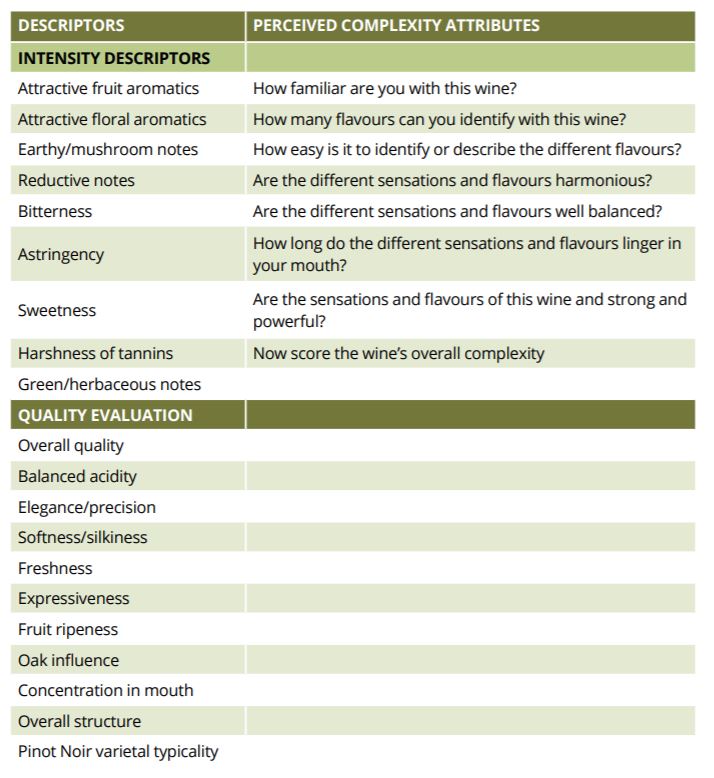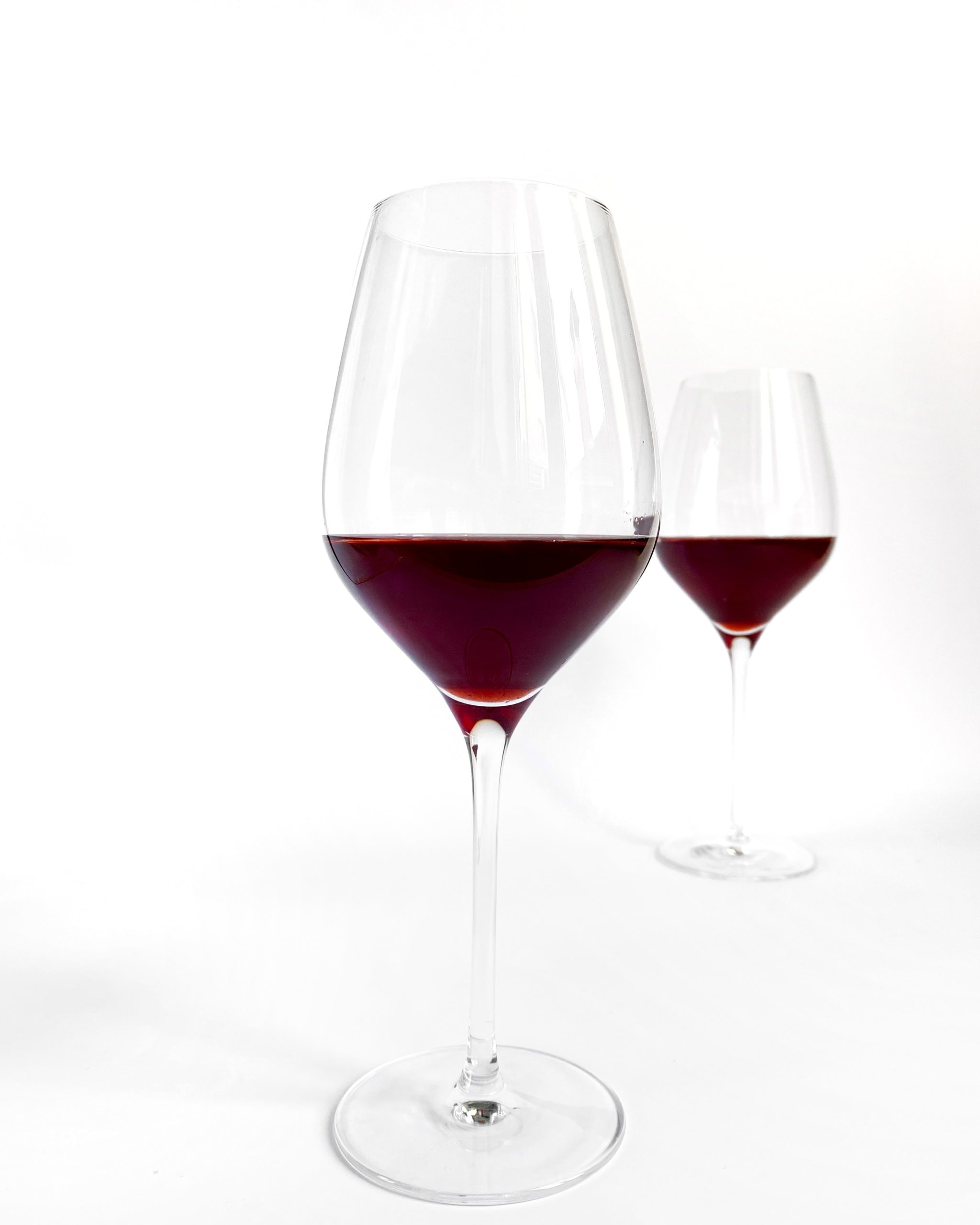Elucidating the nature of perceived quality in Pinot noir: Preliminary sensory data from a study involving New Zealand wine professionals
1Wendy V. Parr, 2Claire Grose, 3Marcela Medel, 4Duncan Hedderley, 5Oliver Masters & 6Dominique Valentin
1Lincoln University, Christchurch, NZ; 2Plant and Food Research, Marlborough, NZ; 3University of Chile, Santiago, Chile; 4Plant and Food Research, Palmerston North, NZ; 5Tripwire Wine Consulting Ltd. & Misha’s Vineyard, Central Otago, NZ; 6University of Burgundy, Dijon, France.
Intrinsic quality is an abstract but important attribute of foods and beverages for both aesthetic and economic reasons. However, what is quality? More pertinently, what is quality in wine? Is it that outside of a wine being fault-free, perception of quality is largely a subjective matter such that every judgment has validity as some argue it does in other areas of aesthetic assessment (e.g., in the world of fine art)? Or, can we adopt a more objective stance regarding perception of wine quality, assuming that external norms (e.g., flavour intensity; balance; harmony of components) exist and comprise a standard against which a wine can be judged? In the research described in this article, we have taken a scientific approach to investigate wine quality, arguing that perception of intrinsic quality is a sensory and cognitive process, with perceived quality a concept that attempts to bridge the space between objective characteristics of a product and a taster’s appreciation of that same product.
The New Zealand (NZ) Ministry for Business, Innovation and Employment (MBIE), in collaboration with New Zealand Winegrowers, has funded a multidisciplinary, inter-institutional research programme investigating Pinot noir. This research programme includes a wine sensory project aimed at shedding light on the somewhat elusive concept of quality in Pinot noir wine. Over the last 18 months, a collaborating team of scientists and wine industry professionals has been attempting to delineate the nature of perceived quality in NZ Pinot noir as judged by wine professionals. Our first point of focus concerned unravelling the wine attributes perceived as important to, even essential to, a quality Pinot noir wine.
Pinot noir, considered one of the world’s fine wines, offers a sensorial experience beyond just primary flavours, this experience giving rise to textural descriptions such as “an iron fist in a silk glove”. Therefore our research focused on both flavour and textural qualities anecdotally considered important in Pinot noir wine. We also investigated more abstract concepts including perceived complexity, elegance, varietal typicality and familiarity of a wine to the taster, and the relationship of these abstract attributes to judgments of overall quality. A further aim was to consider if perceived wine quality was associated significantly with extrinsic factors of NZ wine region, method of production, vine yield, wine vintage, and wine retail price.
What have we done so far?
We invited NZ wine professionals based in Marlborough to assess NZ Pinot noir wines in two experimental tastings, one in November 2018 and a second in June, 2019. Both tastings employed the same 18 wines, the wines having been pre-selected at an earlier date by a panel of experienced wine professionals to exemplify the wide range of Pinot noir wine currently produced in NZ and available to consumers and the international market. The current article describes outcomes from the first experimental tasting only. The second tasting focused specifically on in-mouth aspects (i.e., tastes and mouthfeel qualities) of the Pinot noir wines and these data will be reported at a future time.
In the first tasting, 22 wine professionals judged the 18 Pinot noir wines on 20 selected sensory attributes (see Table 1). Each wine was assessed twice, once in clear wine glasses and once in opaque (black) glassware. The wine qualities selected for rating were considered varietally important to Pinot noir wine (e.g., tannin harshness; aromatic qualities) and/or known to influence perception, judgement, and purchase behaviour related to food and beverage products (e.g., familiarity). After completing this attribute-rating task, the 22 tasters assessed each wine on an 8-item, Perceived Complexity Questionnaire. Influence of wine colour, considered a particularly relevant factor in Pinot noir wine due to lower concentrations of anthocyanins and tannins relative to other red wines, was investigated indirectly by the clear versus black glassware manipulation. The black glassware inhibited ability of a taster to see a wine’s colour, and provided a tasting context where the taster’s smell, taste and mouthfeel judgments were unlikely to be influenced (i.e., biased) by a wine’s colour. Finally, we considered influence of extrinsic, viniviticultural factors of NZ wine region (Wairarapa; Marlborough; Nelson; North Canterbury; Central Otago), vintage (2016; 2013), wine price (commercial = < $30.00; premium = >$30), vine yield (< or > than 2 kg/vine), and means of production (conventional or in transition; organic/biodynamic certified).
Major results of the study to date include the following. First, the 18 wines (RRP = NZ$13.00 – NZ$140) differed significantly in terms of both perceived quality and perceived complexity, with these two attributes positively correlated for most wines. Second, specific attributes driving judgments of perceived quality were largely positive associations and included attractive fruit aromatics, attractive floral aromatics, freshness, expressiveness, fruit ripeness, oak influence, overall structure, concentration in mouth, and balanced acidity. Negative predictors of quality were green/herbaceous and reductive notes. Global wine factors of varietal typicality, familiarity, elegance/precision and complexity were closely associated with judgments of a wine’s overall quality. Attributes that did not show a significant relationship with overall quality were the taste of bitterness and the trigeminal nerve effects of astringency and harshness of tannins. This null result is most likely due to large differences amongst tasters in rating these in-mouth attributes, rather than suggests that these attributes are not of extreme importance to judgments of Pinot noir quality. We have followed this up in our subsequent experiment, and these data will be reported in due course.
In terms of viniviticultural factors, there were few significant effects, most likely due to the low numbers of wines in some categories (e.g., in each wine region), and the variability of wines within a region. Of importance, the green/herbaceous attribute associated statistically with factors of wine region, price, vine yield and production philosophy where it tended to score higher in Wairarapa wines or in conventional philosophy wines. Wine price/vine yield (higher price; low vine yield) also associated positively with several wine attributes that were demonstrated in our sensory data to be important to Pinot noir perceived quality (e.g., attractive floral aromatics). In terms of vintage effects, green/herbaceous, astringency, bitterness, and harshness of tannins were judged significantly higher in two of the three 2013 wines relative to the 2016 wines from the same producer.
The final result we report here concerns influence of colour; observing a wine’s colour does not appear to be the major driver of Pinot noir chemosensory judgments (smell; taste; mouthfeel) by wine professionals. This is in agreement with our prior, published work involving NZ and Burgundy Pinot noir wines and NZ and French tasters. However, results did show some effects, notably that many positive attributes of Pinot noir wine (e.g., aromatic intensity; silkiness) were judged higher in the clear glass condition than when a taster could not see the wine’s colour. In an attempt to better understand the colour effects in the present study, i.e., the influence of tasting glass colour (clear/dark), we associated our judgments of perceived quality to the 18 wines with wine colour instrumental (UV-Spectrophotometer) measures of colour density and hue that were undertaken by Auckland University researchers in the NZW-led Pinot noir research programme. The combined sensory-instrumental data analysis suggests that influence of a wine’s colour was most prominent for wines at the lower end of the perceived quality spectrum. For these wines, colour density (depth of colour) and hue (e.g., red/blue – brick/browning) both influenced judgments shown in our sensory data as important to Pinot noir perceived quality (e.g., freshness; attractive aromatics). In due course, our sensory data will be associated with other relevant wine physico-chemical data, notably aroma chemistry and phenolic analyses.
In conclusion, our work to date has provided evidence that particular chemosensory attributes, not least those subsumed within the umbrella concept of varietal typicality, are important drivers of perceived quality in Pinot noir wine. In collaboration with chemistry colleagues, we have also provided evidence that a wine’s colour density and hue (e.g., browning) may be used by wine professionals as a cue, influencing smell, taste and mouthfeel phenomena, in particular when judging wines at the lower end of the perceived quality spectrum. In terms of practical implications, the demonstrated associations of wine price/vine yield and perceived quality, an inverse relation between the green/herbaceous note and perceived quality, and the positive relation between the green/herbaceous note and conventional production methods, all provide a starting point for industry members to consider. From an oenological perspective, our data show the importance of freshness, attractive floral and fruit aromatics, expressiveness, fruit ripeness, and overall structure to a quality Pinot noir, and a clear negative association with sulphide reduction and green notes.
Table 1. Wine attributes assessed in the 18 Pinot noir wines

This article first appeared in the August/September 2019 issue of New Zealand Winegrower magazine

















